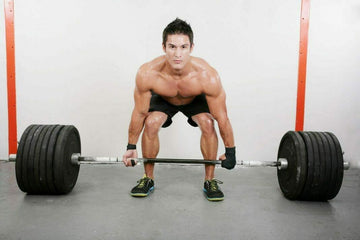Deadlifts are one of the most effective and basic exercises in strength training. They are one of the so-called basic exercises because they not only target a large number of muscle groups at the same time, but also promote functional strength and stability. The correct deadlift requires a clean technique to avoid injuries and achieve maximum results. In this article, you will learn what deadlifts are, which muscles they train and how to perform them correctly.
What is deadlifting?
The deadlift is a multi-joint exercise in which a barbell is lifted from the ground and pulled up to the hips. It is one of the most basic strength exercises that challenges the entire body. From the back to the legs to the arms and core - the deadlift trains both large and small muscles and is therefore highly transferable to everyday movements and other sporting performances.
These muscles are trained during deadlifts
Deadlifts are one of the most complex exercises because they activate many muscle groups simultaneously. The primary muscles targeted include:
• Erector spinae : Stabilizes the back and ensures that the spine remains straight during movement.
• Thigh muscles (quadriceps) : Plays a major role in hip extension and leg stabilization.
• Gluteus maximus : Supports hip extension and stabilizes the pelvis.
• Core (abdominal muscles) : Stabilizes the entire movement and prevents the upper body from collapsing.
• Grip strength (forearm muscles) : Since the dumbbell has to be held, the grip strength is also heavily stressed.
Due to the comprehensive muscle engagement, deadlifts are particularly effective for building strength and improving body stability.
The correct technique for deadlifts
For deadlifts to be safe and effective, the correct technique is important. Poor execution can lead to back injuries, while a clean technique maximizes training success. Here are step-by-step instructions:
1. Starting position
• Stand in front of the barbell with your feet hip-width apart so that your feet are positioned approximately under the barbell.
• Grip the bar with an overhand grip or mixed grip (one hand overhand grip, one hand underhand grip) approximately shoulder-width apart.
2. Keep your back straight
• Bend your knees slightly and push your hips back to get into a squatting position. Your back should be straight and your head should be in line with your spine.
• The chest is stuck out and the shoulders should be positioned slightly in front of the barbell.
3rd lifting movement
• Push yourself up forcefully from your heels while pulling the barbell up in a straight line along your body.
• Keep your back straight and tighten your core. As soon as the barbell is at knee height, push your hips forward and stretch your upper body.
4th final position
• In the final position, you stand upright with your hips and knees straight. The barbell rests at hip height, your shoulders are back and you look straight ahead.
5. Repatriation
• Lower the barbell in a controlled manner by first pushing your hips back and then bending your knees slightly. The barbell should be brought back to the floor in a straight line.
Common Deadlift Mistakes (and How to Avoid Them)
Although deadlifts are a very effective exercise, many exercisers make mistakes that can reduce their effectiveness or increase the risk of injury:
• Rounded back : One of the most common mistakes. Always make sure to keep your back straight throughout the movement. A hollow back or a rounded back can lead to back injuries.
• Too much knee bend : Avoid turning the deadlift into a squat. The hips should be pushed back significantly to activate the glutes and lower back.
• Dumbbell too far away from the body : The dumbbell should always be held close to the body. If the dumbbell is too far forward, the pressure on the lower back increases.
• Uncontrolled lowering of the barbell : Avoid dropping the barbell. Control the movement even when lowering to challenge the muscles throughout the entire movement.
variations of the deadlift
Deadlifts can be performed in different ways, depending on which muscle groups you want to specifically train:
• Sumo deadlift : In this variation, you stand much wider than in the standard version, which puts more strain on the thigh muscles.
• Romanian deadlift : In this version the knee remains almost straight, which puts the focus on the hamstrings and lower back .
• Deadlifts with dumbbells : This variation can be used as an alternative to the barbell to train the core and balance even more.
• Single-legged deadlift : In addition to training the large muscle groups, it also trains stability and balance.
Frequently Asked Questions About Deadlifts (FAQ)
How much weight should I use when deadlifting?
Beginners should start with light weight to learn the correct technique. The weight can then be gradually increased once the exercise is performed safely and in a controlled manner.
Is deadlifting dangerous for your back?
No, deadlifts are not dangerous when performed correctly. In fact, they can help strengthen your back and prevent back pain. However, it is important to keep your technique clean and keep your back straight during the movement.
How often should I incorporate deadlifts into my training?
Since deadlifts are a very demanding exercise, it is enough to incorporate them 1-2 times a week . Make sure to give your muscles enough time to regenerate.
Should I use a weight lifting belt?
A weight lifting belt can be helpful for stabilizing the lower back when lifting heavy loads, but beginners should start without a belt to strengthen natural core stability.
Conclusion: Deadlifts – The key to more strength and stability
Deadlifts are one of the most important exercises in strength training. Not only does it strengthen the back muscles , but it also trains the lower body and improves core stability . With the right technique and a conscious approach, you can significantly improve your strength, posture and stability. Make sure you always train cleanly and increase the weight gradually - then deadlifts will become one of the most effective exercises in your training plan!





